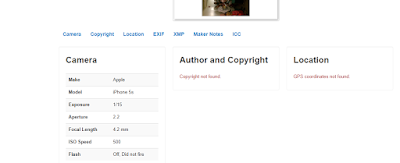So what are we to do about these geotags? If you take pictures with your phone or other device and are unsure if you have privacy settings already in place to eliminate those tags, you can check it out using a website called metapicz.com. Basically just type in http://metapicz.com and you will see a site which you can upload a photo to and it'll tell you where it was taken, along with other information such as what device took the picture and etc (it it's available within the picture.)
Here's an example!
 |
| So here's the top portion of the landing page. You can simply drag a photo into the gray block and the data held within the photo is shown below the block. |
 |
| Hopefully your results will not have a location listed, though they may tell something about you (such as what device you used to take the picture) |



































